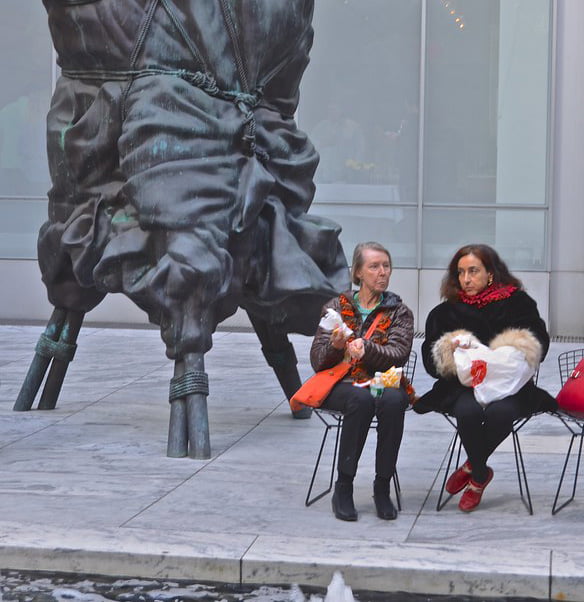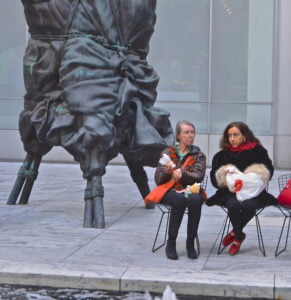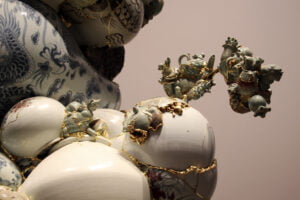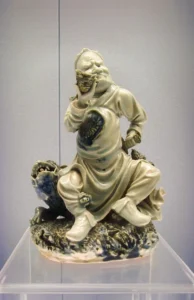The Archetypes of Pretension
The art gallery is a stage, and the spectators are its players, each performing their carefully crafted roles. Here are some of the archetypes you’re bound to encounter:
The Pseudo-Intellectual: This individual can be found pontificating loudly about the “semiotics of postmodern abstraction” or the “dialectical relationship between form and void.” Armed with a vocabulary straight out of an art theory textbook, they revel in their ability to obscure rather than illuminate.
The Silent Judger: Often seen with arms crossed and a perpetually furrowed brow, the Silent Judger roams the gallery with an air of superiority. They rarely speak, but their disdain is palpable. Every artwork seems to fail their exacting standards, and every other visitor is an affront to their refined sensibilities.
The Name-Dropper: “I had a conversation with Damien Hirst about this very piece,” they might say, casually slipping in references to famous artists they’ve supposedly mingled with. The Name-Dropper’s goal is to establish themselves as an insider, someone who moves in the highest circles of the art world.
The Self-Proclaimed Artist: Clad in eclectic clothing and often sporting a dramatic accessory like a beret or oversized glasses, this spectator is always ready to share their own “work in progress.” They see themselves as a peer to the artists on display, frequently drawing comparisons between the exhibited pieces and their latest avant-garde project.
The Allure of Pretentiousness
What drives these spectators to adopt such pretentious personas? At its core, pretentiousness in the gallery scene is about status and belonging. Art galleries, especially those in cultural hubs like New York, Paris, or London, are seen as exclusive spaces where cultural capital is on display. By projecting an air of sophistication and insider knowledge, these individuals seek to elevate their own status within this world.
The Impact on the Art Experience
While these spectators can be amusing, they can also detract from the genuine appreciation of art. Their presence can create an atmosphere of intimidation, making it difficult for others to engage with the works on display. For many, the fear of being judged or not understanding the “correct” way to view art can be paralyzing.
“I’ve seen people leave exhibitions feeling deflated because they felt out of place,” says gallery owner Sarah Whitmore. “Art should be accessible and inspiring, but the behavior of some spectators can make it feel exclusive and unwelcoming.”
The Case for Authentic Engagement
Despite the pretentiousness, there are many who approach art with genuine curiosity and openness. These are the spectators who ask questions, share their impressions without pretense, and view art as a source of inspiration rather than a status symbol.
“Art is about connection,” says contemporary artist Jason Lee. “It’s about how a piece makes you feel, what it makes you think about. You don’t need a degree in art history to have a valid opinion. The most profound insights often come from personal experience and emotional response.”
Navigating the Gallery Scene
For those looking to navigate the gallery scene without succumbing to pretentiousness, here are a few tips:
Be Curious: Approach each artwork with an open mind. Ask yourself what it makes you feel and why. Don’t be afraid to ask questions or seek out information if something piques your interest.
Avoid Jargon: You don’t need to use complex terminology to discuss art. Speak from the heart and share your genuine thoughts and impressions.
Respect Different Perspectives: Art is subjective, and everyone’s interpretation is valid. Avoid dismissing others’ opinions and instead, engage in open and respectful dialogue.
Enjoy the Experience: Remember that art galleries are spaces for enjoyment and exploration. Take your time, move at your own pace, and savor the opportunity to experience creativity in its many forms.
Advertisement
Conclusion: Beyond the Facade
The world of art galleries is rich and diverse, filled with both genuine enthusiasts and pretentious spectators. While the latter can be a source of frustration, they are also a reminder of the complex interplay between art, status, and identity. By focusing on authentic engagement and personal connection, we can move beyond the facade and truly appreciate the transformative power of art.
So next time you find yourself in a gallery, remember: it’s not about impressing others or proving your sophistication. It’s about connecting with the art, the artists, and perhaps even discovering a little more about yourself in the process. Whether you’re a seasoned aficionado or a first-time visitor, the art world is there to explore, not to conquer.











